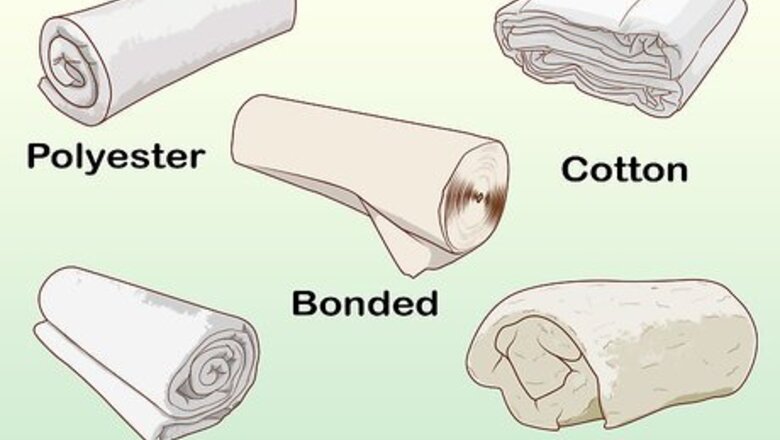
views
Gathering Your Materials
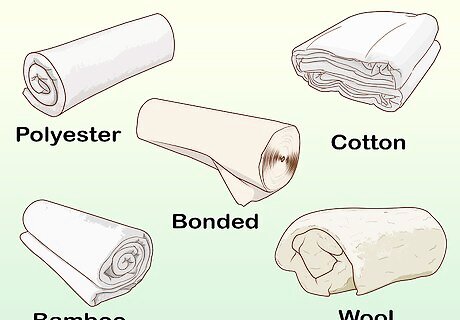
Choose the batting for your blanket. Batting is padding which fills your blanket up. You can buy prepackaged batting (insular material) in Twin, Queen, and King sizes at your local fabric or craft store. You can also buy a custom size directly off of the bolt in store. If you go the custom route, you will want to make sure that your batting is rectangularly shaped (Twin-sized batting, for example, is 72X90 inches) so that it covers your entire body lengthwise. The size of the batting you choose to buy will depend on how large you want your blanket to be. Prepackaged batting usually comes in standard widths of 45 and/or 60 inches. However, if you buy the batting custom cut, you can get it in any size you wish. You can choose either cotton or polyester batting. Cotton is more soft to the touch, while polyester is stiffer. Often cotton batting comes pre-shrunk as well which is a bonus. You will also need to choose whether your batting will be high or low-loft quality. High-loft quality is a thicker batting. Low-loft quality is a thinner batting that helps to lay your blanket out flat. Try to find batting which is in sheet form rather than loose. Sheets of batting are much easier to handle, cut, and sew.

Pick the flannel you want for your blanket. There are many different designs out there on the market, including floral, animal print, and striped. You may also find a solid color you like such as a dark green or hot pink. The choices are nearly endless. Note that the color of the flannel will appear when you either use or fold your blanket, so you may want it to match the surroundings, such as the cushions in your living room. Because flannel comes in so many different colors you can, in general, only buy it prepackaged. If you are making a custom-sized blanket, buy a prepackaged flannel which is slightly larger than the size of your blanket. You can then cut it down to the proper size later on. The labels on the prepackaged flannel will also detail the thickness, which varies depending on the brand.
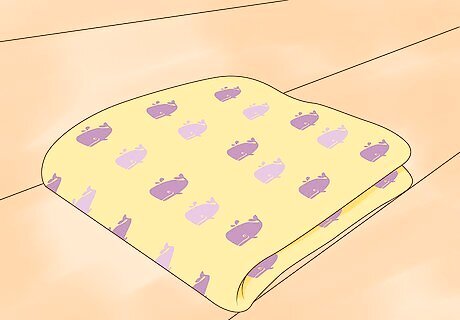
Buy some plush fabric. There should be a section at your local arts and crafts store which sells "Soft and Comfy" fabric. Plush fabric is made of 100% polyester fiber and comes in different styles such as shaggy, stripes, dots, and fluffy. Choose a plush fabric which goes with your flannel design and color. Usually, people go with white as their plush fabric which goes with any color, but you can choose whatever color or design you like. If you buy plush fabric off of the bolt, make sure that you get the same dimensions as both the flannel and batting. If you buy it prepackaged, make sure that it is slightly larger than the flannel and batting so that you can cut it down to the proper size later on. Since this is the fabric which will touch your skin as you lay underneath, you will need to check whether the material bothers your skin. You should also check the added dyes in the fabric and whether or not you have an allergy to it.
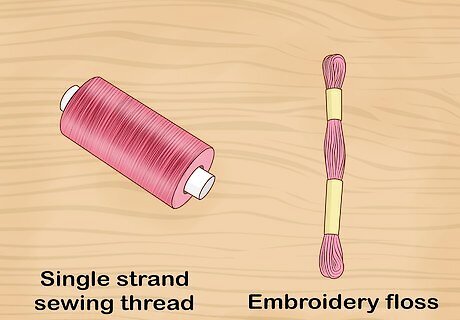
Purchase the correct thread. If you will be using a sewing machine, you will need to buy standard, single strand sewing thread. If you wish to hand-sew the blanket, you should grab some 6-count embroidery floss. Even if you decide to use a sewing machine, you will still need some 6-count embroidery floss to finish the blanket's edges. Try to get a color which matches the flannel and plush fabric. If you wish to see the stitch design, make sure to purchase a high contrast color of thread and embroidery floss. You will also need to buy a needle with a large eye so that the 6-count embroidery floss can easily slide through.

Wash your fabric. Do this before you begin sewing. This will prevent the blanket from shrinking into a strange, uneven shape when you wash it. If the flannel and plush fabric are both prepackaged, you can wash them normally with cool water and safe fabric detergent. It they were cut directly off of the bolt, and therefore cut, put them in separate mesh laundry bags. You can then wash them with cold water and safe fabric detergent. You do not have to wash the batting if it is already preshrunk. If it isn't preshrunk, gently hand wash the batting with cool water, a soft washcloth, and a touch of fabric detergent. Run it under cool water when you are done to get the fabric detergent out. The flannel and plush fabric can be dried in your home dryer on low heat. Batting that has been washed should hang dry.
Sewing Your Blanket Together
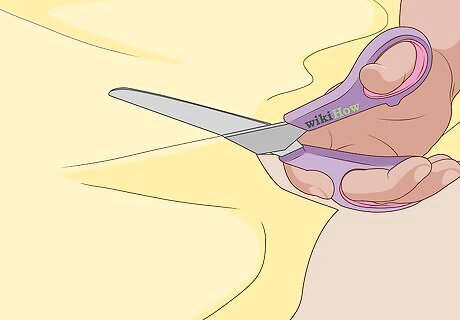
Cut off excess edges. This step is only for people starting with different sized fabrics. You need to have them all the same size before you begin to sew. Place all three fabrics (flannel, batting, and plush fabric) on top of one another. Match all three up at one corner, so that the sides coming off of that corner are flush with one another. Pin the pieces of fabric together so that they do not slide as you cut them. You can either cut them with a pair of scissors or a rotary blade. If you use a rotary blade, make sure you do the cutting on a safe surface. Cut the fabric in sections. You can use a ruler as you go down to make sure that the dimensions of your fabric stay the same down. Use a small, light pencil mark when you are marking where you want to cut.
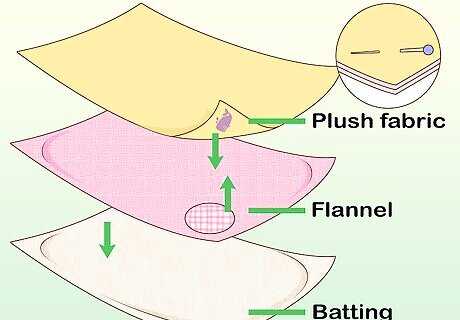
Line your fabrics in the correct order. After you have your fabric cut, and they are all equal sizes, lay down your batting on a smooth tabletop. On top of the batting, place the flannel right side up. On top of the flannel, place the plush fabric right side down. This means that the flannel and plush fabric right sides will be facing one another. Once you have them in the correct order on top of one another, straighten them out. Place pins through the inner part of all three layers so that they stay straight when you begin to sew.
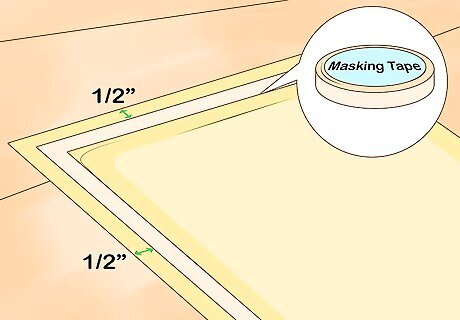
Place tape on top of your fabric. This means you will be placing tape around the backside of your plush fabric. For example, if you want a 1/2 inch inseam, place masking tape around your rectangle 1/2 inch from the edge of the fabric. The edge of your tape will be 1/2 inch away from the edge. Use a ruler or a straight edge to keep the masking tape straight. Leave the tape on until you are sewed. You can also replace the tape with a simple light pencil line, although this may be hard to see as you are sewing.
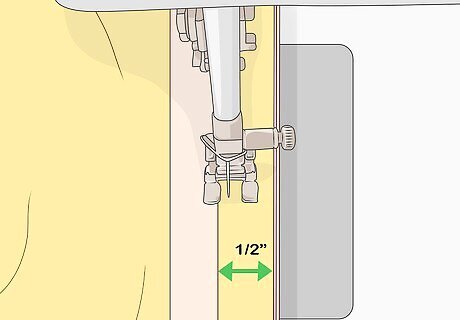
Use your sewing machine. Place the fabric underneath the needle of your sewing machine. Go slowly, and pull consistently, as you move your fabric down. Make sure the seam of your thread is sewing on the outside edge of the masking tape (1/2 inch away from the edge of the fabric for a 1/2 inch inseam). You can create curved stitch marks at the corners, or stop your sewing machine, and reposition your material 90 degrees so that you create a sharp sewn corner. When you get close to finishing, leave a hole about 6-8 inches long, from where you stopped to where you began sewing.
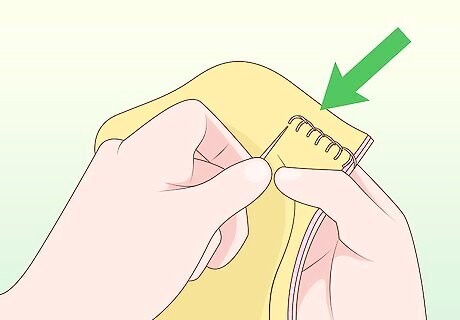
Sew your blanket by hand. If you do not have a sewing machine or prefer a more handcrafted look, choose this step instead of the previous one. First, you will need to thread your needle with 6-count embroidery floss. On the long, hanging end of your thread, tie a knot. Start at the corner of your blanket, and move down the sides. Stick your needle in the underside of the corner of just the plush fabric. Pull the needle all the way through until the knot catches. Pull your needle around the edge of the three fabrics. For more information on the blanket stitch, see: How to Sew Blanket Stitch Stick your needle underneath the batting, and through the top, already threaded hole in the plush fabric. Pull the thread through, while holding a finger near the edge of your fabric so that the thread does not pull through all the way. Stick your needle through the loop created by your finger. Pull the needle all the way through until the stitch is tight. Stick your needle underneath the batting, about 1/2 inch away from the previous stitch, moving downwards. Slide the needle through all three fabrics, while keeping your finger near the edge to create a loop. Stick your needle through the loop and pull tight. Repeat the previous step over and over again, until you have made your way around the blanket. If you need to add another piece of floss, simply tie a knot and begin again at the spot where you left off. Remember to leave a 6-8 inch hole between where you finally end, and where you began sewing.
Finishing Your Blanket

Trim the excess. You do not want a bulky edge for your blanket. Use a pair of scissors or a rotary blade to cut around the edge of your blanket, about 1/4 inch away from the inseam. If you use a rotary blade, make sure you are using a safe surface to cut on. After you have trimmed the excess, you can peel off the masking tape, and pull out the pins that were stuck in your blanket to hold it down.
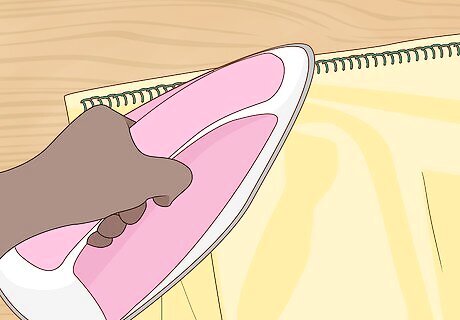
Iron down what is left of the edges. Pull up the edge of the top layer of plush fabric. Take your iron, turn it on low, and gently press the edge of the fabric down. Make sure that when you pick the iron up, the edge of the fabric stays flat. Do this around the edge of the blanket. Once you are done with the top edge, flip your blanket upside down. Turn your iron on low again, and press the edge of the flannel down. Do this around the edge of the blanket.
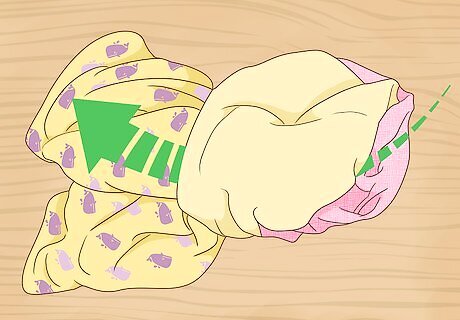
Flip your blanket inside-out. Up until now, the batting has remained on the outside, and the plush fabric has been right side in. Stick your hand in the hole between the flannel and plush fabric (not between the flannel and batting). Push your hand in until you can feel the seam on the other side and gently pull. It is important to do this slowly so that you do not accidentally rip out any of the stitching. Once you get the bulk of it flipped inside-out, tuck your hand back into the hole and poke your finger into the corners. You can also pull from the outside to make them straight and not bunched inward.
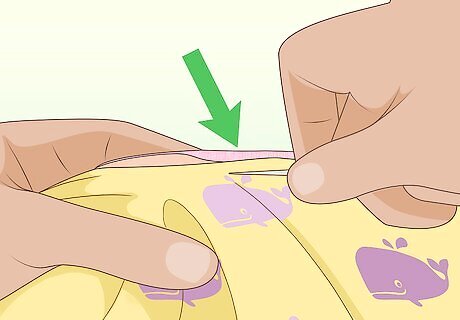
Sew up the hole. Turn your blanket over so that the plush fabric is on top. Just like before, the goal is to sew a blanket stitch. Slide the 6-count embroidery floss through the eye of your needle. Tie a knot at the long, loose end. slide it underneath the plush fabric, and out the top, until the knot catches. Note: you are only sliding the thread through the plush fabric, not the flannel or batting. For more information on the blanket stitch, see: How to Sew Blanket Stitch Take your needle around the edge, and slide it into the flannel underneath. Stick your needle through the three fabrics, and up through the hole you already sewed through. As you are pulling the thread through, place your finger on the edge of the fabric so that the thread does not go all the way through. Take your needle and slide it through the loop you created with your finger. Pull the thread tight. Slide your needle underneath the flannel about a 1/2 inch down from the previous stitch. Slide your needle through all three fabrics as you hold your finger on the edge of the blanket to catch the thread. Put your needle through the loop you created with your finger, and pull your thread tight. Repeat the previous steps over and over again until you have stitched the hole together. Tie a knot in the thread when you are done.




















Comments
0 comment